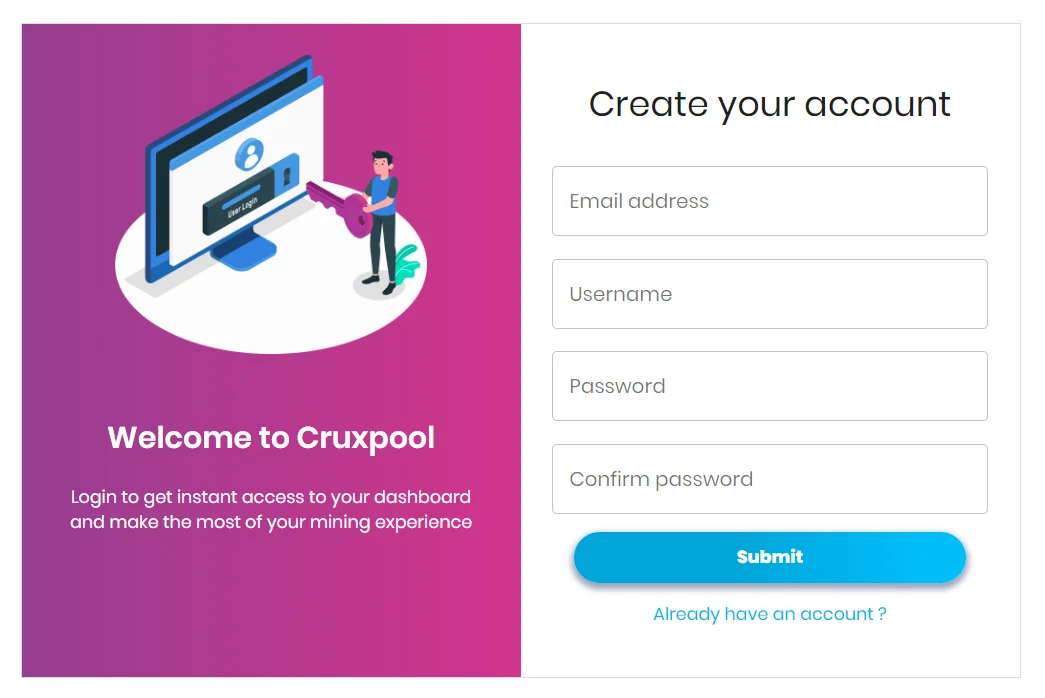How to start mining?
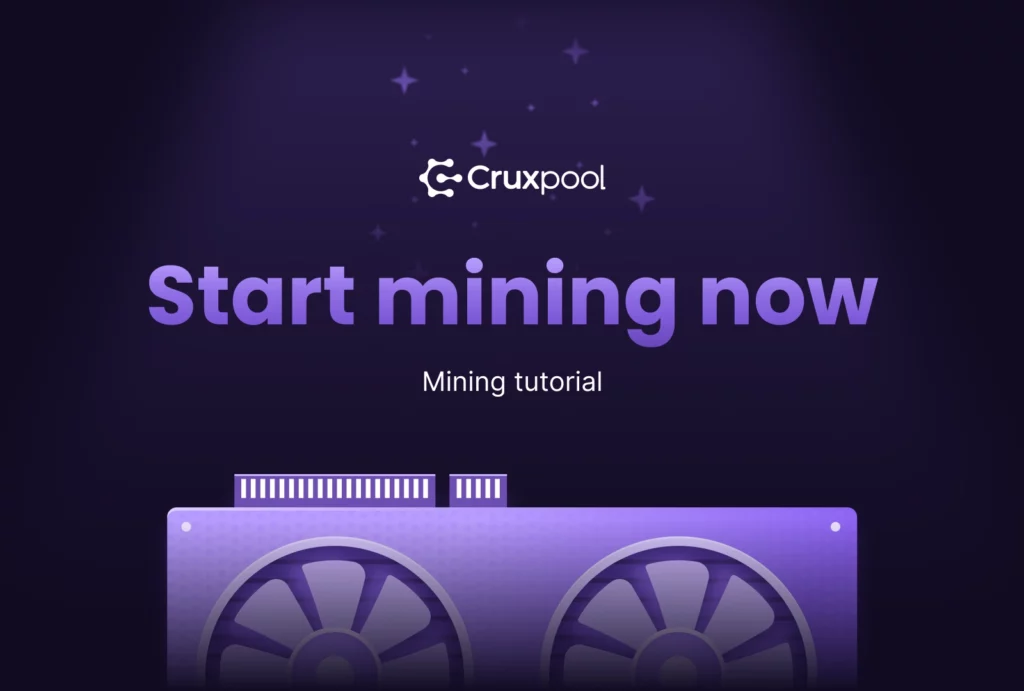
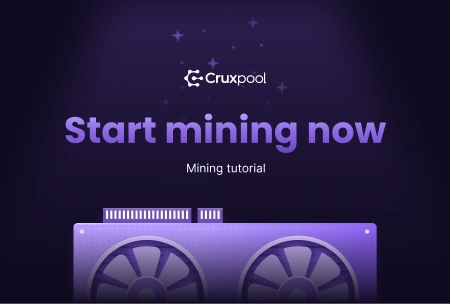
If you are here, it is because you want to start mining. But you are still unfamiliar with the concept of mining and do not fully understand the activity of the miner. Start mining requires preparation, as it is an activity that requires different tools and software.
There are more and more cryptocurrencies that can be mined, which does not make it easy to understand mining activity.
What is mining? How does it work? What tools and software do you need to mine? Focus on how to start mining.
Table of contents
What is cryptocurrency mining?
Mining is the process by which some cryptocurrencies secure their transactions. These cryptocurrencies rely on blockchain technology based on a consensus protocol called Proof of Work (PoW).
In order to validate a transaction on the blockchain network, a miner must provide proof that he is doing work. This work consists of solving a complex mathematical problem. The miner must then find a code composed of numbers and letters, called a hash, to generate the next block of the blockchain. Mining requires computing power that is expensive in terms of hardware and energy, which is why miners rely on this reward to have a reason to participate in the security of the network. It is paid back as a payment in the mined cryptocurrency.
Only computer calculation has the necessary power to find this code. The difficulty of mining evolves over the years according to the number of blocks created. Indeed, it is more and more difficult to find the right hash to create a block.
Mining Bitcoin is difficult and is no longer accessible to individuals. As a result, most people have stopped mining Bitcoin and have turned to other cryptocurrencies. This reason also explains the appearance of mining pools, as we will see later.
Cryptocurrency mining involves:
- The creation of cryptocurrencies in the system.
- Verifying and adding transactions to the public ledger of the blockchain.
Mining is done using a computer connected to the Internet, often equipped with mining hardware and software to control and manage the mining process.
What hardware do you need to start mining cryptocurrencies?
A mining rig
It is possible to mine on your own by equipping yourself with the right hardware for the algorithm of the currency you want to mine. For most cryptocurrencies, mining rigs are very useful.
A mining rig refers to a computer system that is efficient at mining cryptocurrencies. It can be a dedicated miner that has been purchased and built for mining or a desktop computer. In fact, your desktop computer consists of a graphics card that is sufficient for mining. Miners and computers from all over the world are behind the mining process.
Having your own mining rig is ideal because the miner gets all the rewards for his work. The disadvantage is the initial investment which can be a barrier. It is also advisable to have a home equipped with renewable energy or to live in a place where electricity is cheap to avoid high electricity bills.
A graphics card (GPU)
You can also mine with a single graphics card that you use daily with your desktop computer. GPU stands for Graphics Processing Unit. It is an essential component for doing intensive rendering work or playing video games. Most GPUs on the market are dedicated to video games or video production, but they are also used for GPU mining.
With the popularity of cryptocurrencies, there is a shortage of GPUs as many people buy them to mine cryptocurrencies. Mining GPUs have become very expensive, so you will need to find the right opportunity to find a GPU cheaper or at the current price.
GPU hashrate is a crucial piece of data for miners in order to choose a GPU. The hashrate can vary depending on the GPU used. Some of them have specific characteristics giving the miner different options for mining. Your needs in terms of hashrate power and your budget will be key factors in making your choice.
Definition: Hashrate is a measure that represents the computing power per second on a blockchain that uses a Proof of Work validation system.
You should:
- Either go for a high GPU hashrate which impacts your electricity cost, but your investment will pay off quickly.
- Or buy a GPU with a longer investment, but a low power consumption to avoid the big electricity bill.
If you live in a mining-friendly location, there’s no reason not to get started. Mining cryptocurrencies can be very profitable.
If you prefer not to bother with mining equipment, you can also mine with NiceHash by purchasing hash power.
Once you have your hardware to mine (or an account on NiceHash), you can start looking into crypto wallet to keep your cryptocurrencies safe.
Which crypto wallet to choose to start mining?
What is a crypto wallet?
A crypto wallet is where you receive, send and store your cryptocurrencies. There are two main types of crypto wallet: cold wallets (physical wallets) and hot wallets (digital wallets).
Cold wallets and hot wallets share some common characteristics:
- A private key: It must always be kept secret so as not to put your assets at risk. If you forget or lose it, it can mean the loss of your cryptocurrencies! Private keys are usually key phrases consisting of 12 or more words.
- A public key: This is a random string of numbers that works a bit like an alias. It is used to identify your wallet for sending and receiving cryptocurrencies.
Online crypto wallets can be web extensions or applications (desktop/mobile). Software wallets security can be enhanced by a hardware wallet. This is a key that will require a human signature before sending a transaction. If you were to accept risky contracts using DeFi protocols, using a hardware wallet could prevent your funds from being stolen. The most well-known models are the Trezor Model T and the Ledger Nano X and Ledger Nano S keys.
Definition:
DeFi (De centralized Fi nance) refers to decentralized finance. It is a term for financial products and services that are accessible to anyone with an Internet connection. With DeFi, markets are open and there are no centralized authorities that can block payments or deny you access. Services that were previously slow and prone to human error are automatic and more secure because they are managed by every person who can inspect.
Custodial wallet vs non-custodial wallet
As you may know, crypto users are using crypto wallets to store their assets.
A custodial wallet is a wallet whose private keys are held by a third party. This third party has full control over your funds and you only need to give your consent to send or receive payments. Binance allows you to have a custodial crypto wallet.
Unlike a custodial wallet, a non-custodial wallet is a type of wallet that allows you to be your own bank and not go through any third party. This means that you have full control over their funds and the associated private key. MetaMask and Exodus Wallet are well-known examples. The non-custodial wallet also works with seed phrase to further secure your cryptocurrencies.
Definition:
A seed phrase (or mnemonic phrase) is a group of words that provides access to a cryptocurrency wallet. A seed phrase refers to a generated list of 12 to 24 words, in a specific order. This means that any third party who knows your recovery seed can potentially move your funds to another crypto wallet address. It can therefore pose security problems.
Which crypto wallet to choose to start mining?
We are going to focus on hot crypto wallets, so online cryptocurrency wallets. Creating a crypto wallet allows you to buy a cryptocurrency of your choice before placing it directly in your virtual safe that can be unlocked with private keys.
The main advantage of online wallets lies in buying and trading cryptocurrencies with just a few clicks. One can also check the available balance in each cryptocurrency.
The high volatility of cryptocurrencies makes them a risky investment, but with great potential for gains.
There are different crypto wallets that offer to store, exchange and receive various cryptocurrencies. Here are some of them according to the cryptocurrencies that can be mined with our mining pool, Cruxpool, and their availability on the OS:
Choose a mining software for mining
What is a mining software?
Whether you want to mine solo or with a mining pool, you will need software that allows you to interact the computing power of your machine with the PoW consensus of the blockchain you want to mine on.
These softwares can range from a simple command line interface to more advanced interfaces resembling those of commonly used software.
They are software that allow individuals to connect to a mining pool, receive jobs and submit shares (solutions) to be paid. There is software for all minable cryptocurrencies and in all algorithms. This software is the link between the GPU of the individual and the mining pool. Mining software allows you to adapt the raw computing power of your machine to the dedicated algorithm of the chosen cryptocurrency, such as Ethash for EthereumPoW (ETHW).
Mining software can also provide you with useful statistics to monitor the performance of your mining hardware: hashrate, GPU temperature, etc.
Finding and configuring the right mining software for your hardware and needs can be tedious. But once the software is running, there’s not much else to do except check that the device is running properly and that the mining speed is constant.
How to download and set up a mining software?
The installation and programming of a mining software can vary depending on your OS, your GPU and the cryptocurrency you want to mine. It is mainly to explain the major steps for the vast majority of cases.
Step 1: Get the right file from the mining software
Step 2: Create and edit your script in the software


t-rex.exe -a ethash -o stratum+tcp://eth.cruxpool.com:5555 -u 0xD75db27F8419582c98489fBaD17Ce75dC40466F -w TIPHAINELMT -p x
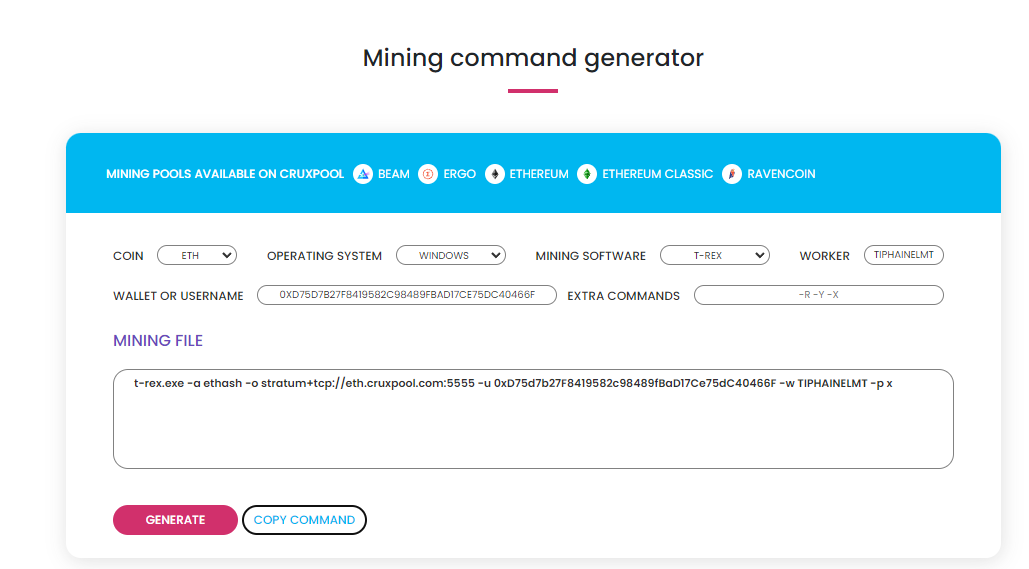
Edit the mining file and fill it with :
- The executable file of the mining software (t-rex.exe).
- The mining algorithm (ethash).
- The address of Cruxpool (stratum+tcp://eth.cruxpool.com:5555).
- The public address of your crypto wallet where you will receive your mined cryptocurrency (0xD75d7b27F8419582c98489fBaD17Ce75dC40466F).
- The name of the miner (TIPHAINELMT).
- A command to add an additional password (you can leave an “x” if you don’t want to put one).
With the Cruxpool mining pool, it is possible not to mention the public address of your wallet but to create an account on Cruxpool. Cruxpool is a French mining pool that gives you the possibility to mine several cryptocurrencies: Bitcoin, EthereumPoW, Ethereum Classic, Ergo, Ravencoin, Beam, Firo and others soon.
Step 3: Save the file according to your OS
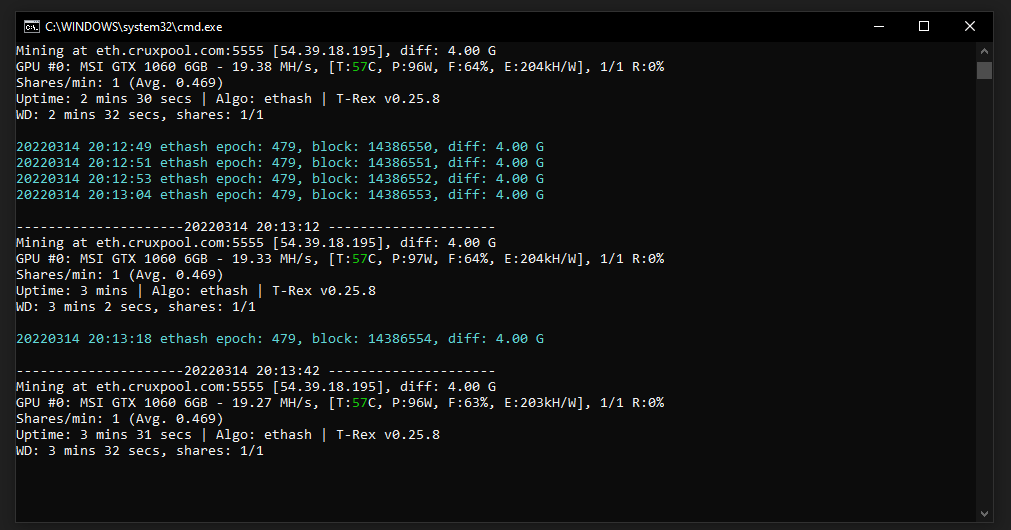
Which mining software to choose to start mining?
Definition:
Transaction fees are mandatory fees applied to each cryptocurrency transaction. These fees vary, depending on the flow of the blockchain and the size of the transaction.
Join a mining pool
To mine cryptocurrencies, the user only needed a computer and compatible software. Today, it has become difficult to mine cryptocurrencies on personal computers due to the computing power required. The solo type of mining has become unprofitable, impractical and too expensive for individual miners. This is why mining pools exist.
A mining pool is a platform that contains special software where a group of miners merge their computing power for more efficient mining of cryptocurrencies.
A miner who wants to reap profits through standard mining can either go solo using their own mining devices, or join a mining pool where one person’s mining resources are pooled with those of other miners in the pool. The goal is to improve the mining yield through enhanced processing.
What is a mining pool like Cruxpool?
A mining pool is a group of miners who work together to increase their chances of finding a block. With the help of these mining pools, miners combine their individual computer resources with those of other members, which improves their processing power and allows them to get a hit faster.
However, this work has a cost. The reward obtained from combined mining is shared among the different members of the pool, whereas the reward obtained from individual mining is proprietary.
A mining pool can be compared to an agricultural cooperative. It is a gathering of farmers (miners) who can have a stable and higher remuneration than if they acted alone with their crops (computing power).
Before deciding to join a mining pool, miners should pay attention to how each pool divides its payments among members and what fees it charges. Mining pools can charge between 1% and 3% transaction fees.
We will show you some examples of reward distribution systems among the participants of the mining pool.
PPLNS (Pay Per Last N Shares)
PPLNS is a proportional payment system. Payout is calculated not according to the number of shares the miner has sent during the interval between found blocks, but according to the number of time intervals, which are called shifts.
PPS (Pay Per Last)
PPS is a system that involves a fixed payment for each share provided by a miner. All work done by the user, whether valid blocks have been found or not, is paid for.
PPS+ (Pay Per Last +)
PPS+ is a mix between PPS and PPLNS. The block reward is paid according to the PPS model and the transaction fees are paid according to the PPLNS mode.
FPPS (Full Pay Per Last)
Block reward and mining service fee are paid based on the theoretical profit. Calculate a transaction fee over a period of time and distribute it to miners according to their hash power contributions. With the FPPS method you will be paid even if you haven’t found the block.
Cruxpool uses FPPS and PPS as a reward distribution system.
How does a mining pool work?
A mining pool functions as a coordinator that manages the work of the mining pool participants. The functions involve managing their hashes, searching for block rewards, recording the work done by each member of the mining pool and allocating reward shares to each member of the pool based on the work done after proper verification.
There are two methods of a miner work in a mining pool:
- The most traditional method is the allocation of a work unit consisting of a range of nonce. A nonce is a number added to the hashed block in the blockchain and represents the number that the members must solve. Once the member of the mining pool has completed the work, it requests the allocation of a new unit.
- The other method of mining gives the miners in the mining pool the freedom to choose how much work they want. The tasks are not assigned by the mining pool. Therefore, this ensures that members work on different units.
To create a new block and participate in the blockchain, you need to solve calculations. At our mining pool Cruxpool, we give the calculations to the members. Pool members are rewarded according to the accepted actions that contributed to the discovery of a new block.
Contribution is called a share (result/contribution). Share can be seen as an attempt to find a valid block. For a submitted attempt, the miner is rewarded. The operator of the mining pool simply checks the validity of the blocks provided to him by the participants.
On the work given by the mining pool, the miners will give the shares of the calculations. When one of the participants finds a valid block, the pool compares it to the current difficulty of the whole network and sends it to the common cryptocurrency network for verification where it is validated by others. Once the validation is received, the pool counts the share of each participant and distributes the reward according to its fee. The block is then added to the blockchain.
Create a Cruxpool account to start mining
With Cruxpool, you can start mining with an account instead of your public wallet address. We have a dedicated tutorial on how to create a Cruxpool account.
There are other advantages to having a Cruxpool account.
Dashboard
If you are mining multiple cryptocurrencies, or switching algorithms based on profitability, we have designed a multi-cryptocurrencies view that allows you to see all the data for each cryptocurrency you have on one web page. You will always have access to the real-time data we have provided so far in the statistics and earnings.
More security and privacy
On the anonymous dashboard, anyone who knew your crypto wallet address could check your rewards, stats and the number of rigs you had. With login, make your life more private and hide your data behind a password protected account.
2FA authentication
2FA module allows you to change your payment address or modify some of your personal information to make your mining experience more secure.
If you want to mine with a username, sign up on Cruxpool.com.
On your new personal account, you will be able to start mining on Cruxpool by entering your username in the command line, instead of your crypto wallet address to save time!
The activity of mining can be considered challenging, but once documented, it becomes easier. We hope we have been able to help you to start mining. If you have any questions, you can join our Discord group dedicated to Cruxpool.
The important thing to remember is that mining requires hardware, a crypto wallet and mining software. For the rest, it is up to you if you want to start mining with our Cruxpool mining pool!
